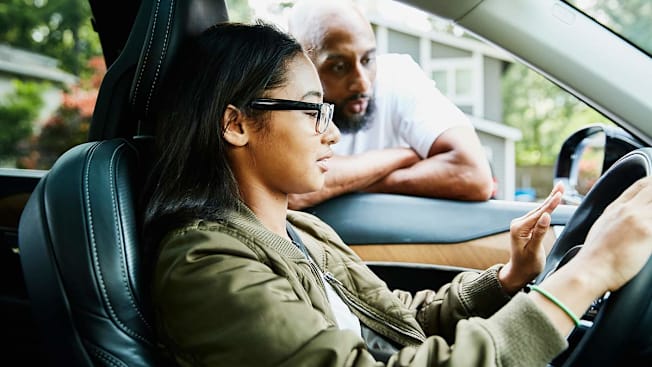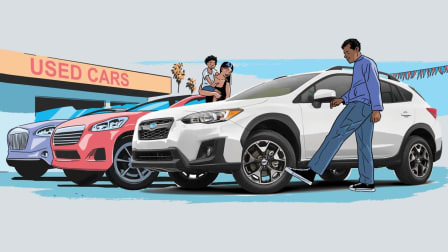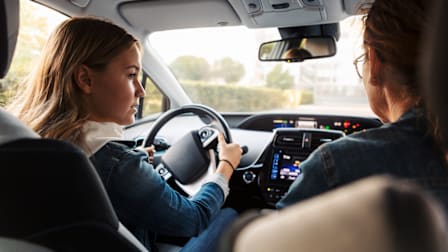What Parents Can Do to Protect Their Teen Drivers
Practical tips for guiding them through these dangerous years

Car crashes are the No. 1 killer of U.S. teens. In fact, the fatal crash rate per mile driven for 16- to 17-year-olds is nearly three times the rate for drivers age 20 and older, according to the Insurance Institute for Highway Safety.
Parents Can Lead By Example
Despite the perception that our teenagers and young drivers profess to know everything, they’re still watching and learning from how their parents behave. The example you set for them behind the wheel may be the most important in terms of actually keeping them safe, more so than any other safety message you’ve given them in their entire life. So make it count.
Whether your teen is driving or you are, be sure to:
Buckle up: Despite seat belt laws in many states, teenagers have some of the lowest rates of seat belt use, especially when they’re passengers. Be sure you buckle up yourself and make sure they do as well.
Put down the phone: Adults must avoid the temptation to take a call or check a text, not only because of the risk it presents but also because of the message it sends to your young driver. Set the example by having your teen send a text or make a call for you.
Slow down: Speed is a contributing factor in almost one-third of motor-vehicle fatalities, according to NHTSA. Young drivers don’t yet have a good gauge of how fast is too fast, so driving slower than you normally would is safer for both of you.
Don’t drink and drive: Be especially aware of the message you’re sending your teen when you’re driving after having a glass or two of wine at a dinner party. Stress the importance of designating a driver, and let your teens listen in on the discussions you have with other adults about the issue.
Consider your own driving contract: Writing down a set of rules—and perhaps more important, the consequences your teen driver will face if they violate them—makes it clear what your expectations are. Sample contracts can be found on many websites, including this one from AAA (PDF), or some insurance companies.
Graduated licensing (GDL) programs in many states have helped take some of the pressure off parents by setting strict driving rules, requiring certain levels of education and minimum hours of driving experience (some with parents along), restricting driving hours, and limiting the number of passengers a new driver can take along. But those restrictions eventually expire, typically around age 18 or once a young driver has had a license for a specified period of time. That’s why it’s important for parents to work in conjunction with GDL rules to help young drivers get as much good driving experience while remaining as safe as possible.
Teen-Focused Car Safety Features
Several automakers offer models with specific features that build on the graduated licensing concept to empower parents to set certain restrictions and provide a means to monitor behavior behind the wheel.
For example, Ford has long offered a teen-focused system, called MyKey, that offers restrictions, including a chime that tones every 30 seconds until the front occupants buckle up. The Ford system has a few other parent-friendly features, such as blocking explicit content on satellite radio, an earlier low-fuel warning, and the ability to keep teen drivers from deactivating safety systems.
Some General Motors models have a Teen Driver mode that allows parents to program limitations, such as setting a maximum speed, and provides a report card that indicates distance driven, top speed, and whether safety systems were used. There is also a seat belt minder that mutes the audio system until the driver, and if applicable, the front passenger, is buckled in.
Many other automakers offer systems that can alert the owner (in this scenario, a parent) when the car is driven too fast or out of a defined area.
Choose the Right Car for a New Driver
It matters what car your teen drives. Our lists of recommended cars for teen drivers are based on a philosophy of helping them avoid a crash and preventing injuries if a crash does occur. These cars have proved to be good performers, safe, and reliable.
But more than that, we narrowed the list of CR Recommended cars to those that aren’t so fast that they invite speeding. We select only those with good braking distances and good scores for emergency handling. Standard electronic stability control (ESC) is not factored into the latest lists because the oldest vehicle featured there is a 2011 model. This vital, proven safety feature has been standard equipment on all new vehicles since the 2012 model year, and it should be on any vehicle that a teen drives.
We’ve broken our list down into new and used cars, including models that cost less than $10,000. Although parents or teens may be tempted by the least expensive vehicle, we think it’s worth it to choose the safest, most reliable vehicle they can afford.
Become an Air Traffic Controller
If you’re the parent of a teen driver, manage your child’s trips with something like an aircraft flight plan. One of the riskiest behaviors for teens is "just driving around." It makes sense that when a teenager has a destination in mind—such as a date, sports event, or party—he or she is more likely to get there safely. In other words, purposeful driving is more likely to result in a safe outcome than joyriding.
Items to include in the flight plan are:
• Destination
• Route
• Time of day they’re traveling
• When they’re expected to depart and arrive
• What car they’re driving
• Their plan for contacting someone
• What their contingency plan is in case something goes wrong
• Confirmation that they feel rested and alert (fatigue is a particular concern for teenagers)
If your teen driver can’t give you specifics on each of these items, maybe the trip is not one they should be taking. And of course, should any of the particulars change during their trip, they should contact you, as the controller, to revise their flight plan.
In short, even when GDL restrictions expire for your young driver, your job in making him or her a better and safer driver isn’t done yet. Monitor what your child does, and remain conscious of your own driving behavior as well.
More on Car Insurance
• CR’s Car Insurance Ratings and Buying Guide
• Best Car Insurance Companies
• Cheapest Car Insurance Companies
• How to Lower Your Car Insurance Rates
• Everything You Need to Know About Teen Car Insurance
• Proven Ways to Save on Car Insurance Even If You’re a Safe Driver
• How to Keep Your Car From Getting Stolen
• How to Prevent Catalytic Converter Theft




















